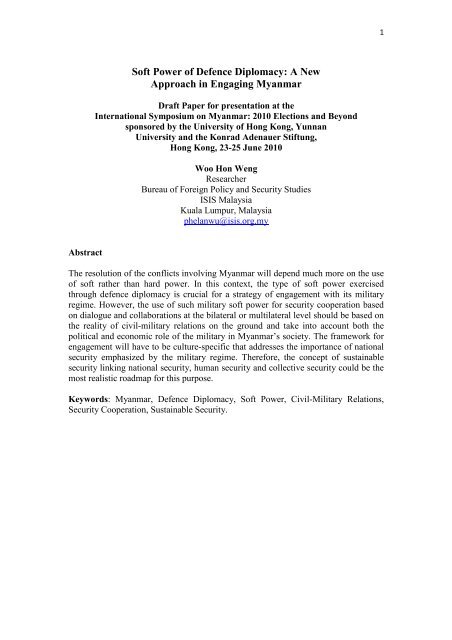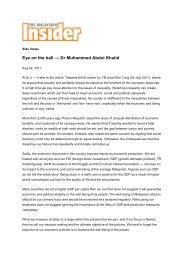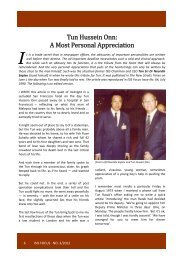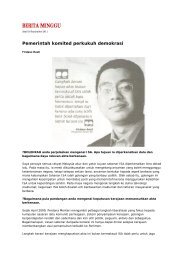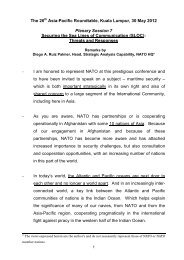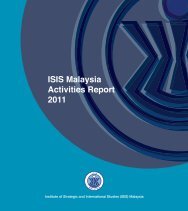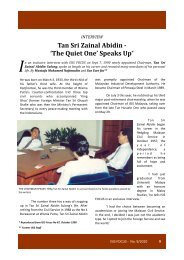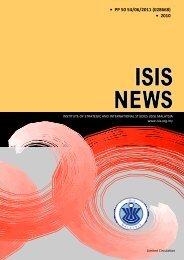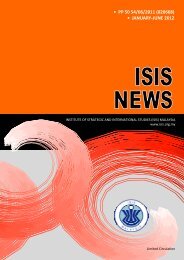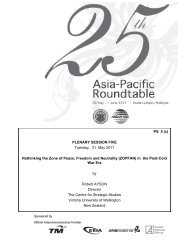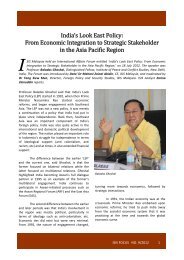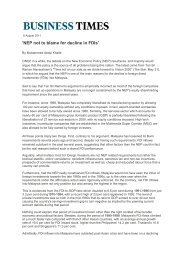Soft Power of Defence Diplomacy: A New Approach ... - ISIS Malaysia
Soft Power of Defence Diplomacy: A New Approach ... - ISIS Malaysia
Soft Power of Defence Diplomacy: A New Approach ... - ISIS Malaysia
Create successful ePaper yourself
Turn your PDF publications into a flip-book with our unique Google optimized e-Paper software.
1<strong>S<strong>of</strong>t</strong> <strong>Power</strong> <strong>of</strong> <strong>Defence</strong> <strong>Diplomacy</strong>: A <strong>New</strong><strong>Approach</strong> in Engaging MyanmarDraft Paper for presentation at theInternational Symposium on Myanmar: 2010 Elections and Beyondsponsored by the University <strong>of</strong> Hong Kong, YunnanUniversity and the Konrad Adenauer Stiftung,Hong Kong, 23-25 June 2010Woo Hon WengResearcherBureau <strong>of</strong> Foreign Policy and Security Studies<strong>ISIS</strong> <strong>Malaysia</strong>Kuala Lumpur, <strong>Malaysia</strong>phelanwu@isis.org.myAbstractThe resolution <strong>of</strong> the conflicts involving Myanmar will depend much more on the use<strong>of</strong> s<strong>of</strong>t rather than hard power. In this context, the type <strong>of</strong> s<strong>of</strong>t power exercisedthrough defence diplomacy is crucial for a strategy <strong>of</strong> engagement with its militaryregime. However, the use <strong>of</strong> such military s<strong>of</strong>t power for security cooperation basedon dialogue and collaborations at the bilateral or multilateral level should be based onthe reality <strong>of</strong> civil-military relations on the ground and take into account both thepolitical and economic role <strong>of</strong> the military in Myanmar’s society. The framework forengagement will have to be culture-specific that addresses the importance <strong>of</strong> nationalsecurity emphasized by the military regime. Therefore, the concept <strong>of</strong> sustainablesecurity linking national security, human security and collective security could be themost realistic roadmap for this purpose.Keywords: Myanmar, <strong>Defence</strong> <strong>Diplomacy</strong>, <strong>S<strong>of</strong>t</strong> <strong>Power</strong>, Civil-Military Relations,Security Cooperation, Sustainable Security.
2The Myanmar ImpasseHistorically, political development and democracy in Myanmar have been held backby a tendency for the country to dissolve into chaos and confusion when it is not heldtogether by a firm rule. The abolition or collapse <strong>of</strong> Burma’s military forces wouldcertainly lead to chaos and anarchy, ceding power to a variety <strong>of</strong> militias andorganized banditry. Therefore, it should be a fundamental objective <strong>of</strong> transition inMyanmar to retain as much as centrally controlled military and police force asnecessary to maintain law and order. This is why the military must participate inreform for it to succeed. 1The political problem was how to organize time to yield will. Greatness <strong>of</strong> a policy ismeasured by the mastery <strong>of</strong> the chronopolitical dimension in the course <strong>of</strong> policyimplementation instead <strong>of</strong> by the breadth <strong>of</strong> a geopolitical vision or the boldness <strong>of</strong> itsgoal or objectives. Time, the most neglected strategic dimension involving duration,sequencing, timing, tempo, and also memory have eluded politicians andpolicymakers whose timelines rarely extend beyond the 24/7 news cycle, quarterlyreports and elections cycle. 2 This can be seen in the context <strong>of</strong> Myanmar with theimpatience for change among the US and its Western allies. Therefore, reform has tobe based on gradualism emphasizing staying power rather than speed as an approachfocusing on: 3• Reform through relief• Democracy through development• Change through continuityThree variables related to the rogue states theory in international relations 4 are crucialto the better understanding <strong>of</strong> the protracted impasse in Myanmar’s current politicalsituation which has dragged on for over 20 years since 1988.First, why do rogues resist the actions <strong>of</strong> the world community and maintain theirrogue behavior? Rogues resist the various efforts at compellence imposed by the greatpower because they perceive a high threat from a more powerful other with imperialambitions to control and dominate. There is a need to recognize that the implicitassumption in much <strong>of</strong> the international relations literature that so-called "status quo"powers are conservative, non-threatening, states may not be shared by leaders aroundthe world. Diplomatic isolation, economic embargoes, attempted subversion andmilitary conflict are common elements in the compellence strategies <strong>of</strong> status quostates. Such behaviors are readily perceived by many leaders and citizens throughoutthe Third World, including the rogue states, as the threatening acts <strong>of</strong> a state intent onimperial control.1 Clapp, Priscilla, Burma’s Long Road to Democracy, Special Report No. 193. Washington D.C.:United States Institute <strong>of</strong> Peace, 2007.2 Corn, Tony, World War IV as Fourth-Generation Warfare, Policy Review, No. 000, Web Special,January 2006., 12 June 2010.3 Len, Christopher, Johan Alvin, Burma/Myanmar’s Ailments: Searching for the Right Remedy.Washington D.C.: Central Asia-Caucasus Institute, 2007, p. 93.4 Hoyt, Paul D., Rogue States and International Relations Theory, Journal <strong>of</strong> Conflict Studies, Vol. 20,No. 2, Fall 2000., 12 June 2010.
3In this circumstance the extent <strong>of</strong> public involvement is generally very high and thetone is hostile. Seeking to create public support for resistance to the perceivedimperial state, the leaders create a strategic culture based on demonizing the externalthreat. Resistance by the rogue to the imperial state is thus seen as the only availableoption. Capitulation is portrayed as tantamount to national suicide given the perceivedthreat posed by the imperial state. It is also politically untenable domestically giventhe embedded strategic culture within the rogue state. This situation leads to acontinuance <strong>of</strong> previous policies, including efforts to acquire more sophisticatedweapons systems and support for those seen as challenging the dominance <strong>of</strong> the greatpower and its allies.Second, why do stronger states desist from removing the rogue? The imperial statefaces a different environment. While the rogue state may pose a danger to valuedinterests, it is not an existential threat and thus is scored as a low threat. Also therelative power capabilities is advantageous. Thus while the great power may have thecapacity to eliminate the rogue, there is no strong motivation for undertaking such aforceful action. Should the rogue, at some time, enhance their capability to a pointwhere the threat perception becomes acute, there should be a strong reaction due tothe altered strategic environment and the subsequent expression <strong>of</strong> public concern.Yet, even at low levels <strong>of</strong> perceived threat, the great power <strong>of</strong>ten maintains amoderately coercive strategy vis-ˆ-vis the rogue states. The critical question here iswhy is Cuba, for example, treated differently (as a rogue requiring sanctions) thanother states in the world which possess similar relative capabilities? This is where therole <strong>of</strong> the attentive public is crucial. Certain sectors <strong>of</strong> the domestic population arehighly engaged regarding policy toward particular states. Their influence isheightened during periods <strong>of</strong> low perceived threat because there are fewer counterinfluences operating. In response to the political power and influence <strong>of</strong> this attentivepublic the government takes a mid-range policy stance, more coercive than in mostlow threat circumstances, but not at a level <strong>of</strong> devoting the political and economiccapital necessary to eliminate the rogue.Finally, why does this relationship persist so long? Rogues maintain their resistanceto the imperial state because their perception <strong>of</strong> high threat from the great power, theyfeel, necessitates resistance. The continued efforts at compellence on the part <strong>of</strong> theimperial state are taken as incontrovertible evidence <strong>of</strong> its unending hostility.Accommodation with such a power is unthinkable. Also, the creation <strong>of</strong> a strategicculture <strong>of</strong> resistance to the imperialist power limits the political options available tothe leadership even if they came to believe accommodation wise. Confrontationbecomes ingrained.From the great power side, the unwillingness <strong>of</strong> the rogue to yield is taken as evidence<strong>of</strong> their unalterable hostility and aggressive intent, feeding the threat perception.Efforts by the rogue to enhance their power capability are also taken as evidence <strong>of</strong>aggressive intent and not as defensive reactionism. However, as long as there is littleexistential threat, there is little governmental or public support for decisive action.The attentive public exerts enough influence to maintain a moderate compellencestance but moves beyond this level are not sanctioned. Thus the actions <strong>of</strong> both partiescreate a cycle <strong>of</strong> mistrust and hostility which both sides, perhaps unwittingly,maintain.
4In the context <strong>of</strong> Myanmar, the fear <strong>of</strong> an invasion has been evident since 1988. Thevindictiveness directed toward the junta by the US which has explicitly called forregime change in Myanmar have led many in the tatmadaw to believe that the US wasseeking a pretext. The Burmese suspected a potential invasion in 1988 when a UScarrier force operated close to Burma to evacuate American dependents. Relief toCyclone Nargis victims in 2008 was also seen by them in such context. Myanmar’smilitary intelligence <strong>of</strong>ficials have pointed out the history <strong>of</strong> US invasions fromGrenada and Panama to Kosovo, Afghanistan and Iraq. 5The sacking and arrest <strong>of</strong> Lt. General Khin Nyunt in October 2004, a moderatemember <strong>of</strong> the junta who have the most knowledge about the external world and themost accessible <strong>of</strong> the junta members to foreigners cut <strong>of</strong>f what little dialogue therehad been. It was Khin Nyunt who negotiated the ceasefires with the ethnic insurgentsand was the person most concerned about foreign contacts, such as ASEAN, andwanted improved international relations. When he was prime minister (August 2003 –October 2004), the SPDC released Suu Kyi from house arrest, embarked on its sevenpointroadmap for democracy, allowed the reopening <strong>of</strong> NLD branches andcooperated with the United Nations Office <strong>of</strong> Drugs and Crime to slash opiumproduction. But rather than rewarding the SPDC for these efforts, the US tightenedsanctions further which were related to the 2002 US congressional elections thatstrengthened the administration’s hardline stance against the junta. His political exilewas partly due to his failure to gain concessions from the West. 6The effect <strong>of</strong> labelling states as failed or rogue can have very significant impacts withthe real danger <strong>of</strong> a self-fulfilling prophecy. 7 In 2005, then Secretary <strong>of</strong> State,Condoleezza Rice branded Myanmar along with Belarus, Cuba, North Korea, Iran andZimbabwe as “outposts <strong>of</strong> tyranny”, and the US tightened financial sanctions againstthe regime and its supporters. This led in turn to the restoration <strong>of</strong> diplomatic relationsbetween Myanmar and North Korea in April 2007 which was severed in 1983 whenNorth Korean agents detonated a bomb in Yangon. In November 2008, Myanmar andNorth Korea signed a memorandum <strong>of</strong> understanding to enhance military cooperationbetween the two countries including a secret program to develop nuclear weapons andballistic missiles to deliver them to deter perceived hostile foreign powers. 8The elections appear to be a gambit by the junta to appease international critics as itmove towards reform with Indonesia and Vietnam representing the regional modelsfor reform. The Indonesian model (military returning to barracks and returningpolitical power to civilian politicians in exchange for immunity) is attractive, but5 Steinberg, David I., Burma/Myanmar: How flourishing the “discipline democracy”? Ganguly, Sumit,Andrew Scobell, Joseph Chinyong Liow (eds), Routledge Handbook <strong>of</strong> Asian Security Studies.London: Routledge, 2010, pp. 280-281.6 Roberts, Christopher, Myanmar Quandry: Fluctuating <strong>Approach</strong>es absent Domestic Change? PlenarySession 7 – Is Myanmar Changing Or Has Myanmar Changed Us? 24 th Asia-Pacific Roundtable, KualaLumpur, 7-9 June 2010; Steinberg, David I., Burma/Myanmar: How flourishing the “disciplinedemocracy”? Ganguly, Sumit, Andrew Scobell, Joseph Chinyong Liow (eds), Routledge Handbook <strong>of</strong>Asian Security Studies. London: Routledge, 2010, pp. 280-281.7 <strong>New</strong>man, Edward, Failed States and International Order: Constructing a Post-Westphalian World,Contemporary Security Policy, Vol. 30, No. 3, December 2009, p. 439.8 Lintner, Bertill, Myanmar’s nuclear bombshell, Asia Times Online, June 5, 2010., 12 June 2010.
5unlikely. Since the fall <strong>of</strong> President Suharto in 1998, the military formally withdrewfrom politics and the country has been led by democratically elected civilianpresidents although the current President Bambang Susilo Yudhoyono is a retiredmilitary general. The junta in Myanmar have little interest in reforms even thoughthey are interested in resumption <strong>of</strong> military ties with the US, including trainingprograms. 9Instead, the military junta is impressed by the Vietnam model <strong>of</strong> doi moi becauseeconomic reform did not lead to political change. Two explicitly stated national goals<strong>of</strong> Myanmar is related to economic reform namely, (1) Building Myanmar to becomea modern developed nation, and (2) Catching-up her ASEAN counterparts first in2015 and then the developed countries like Japan in 2020 and finally in 2030 theindustrialized Western countries in level <strong>of</strong> economic development. 10Few <strong>of</strong> today’s Myanmar top generals possessed any significant internationalexperience. Most were educated at home, speak little English, and rarely go abroad.They mostly lack any understanding about the nature <strong>of</strong> international politics whichpresents a major obstacle to the development <strong>of</strong> a broader outlook. Still, theadversarial aspect should not be overemphasized. The Myanmar worldview does notidentify enemies as such. There is no religiously or ideologically inspired hatredtowards any state. The emphasis is on getting along with everybody, and criticism <strong>of</strong>the US is largely a response to US policy. 11 . This is related to one <strong>of</strong> the greatest USforeign policy flaw which is the failure to recognize the importance <strong>of</strong> national selfdeterminationwhich hinders global economic and social progress. 12<strong>S<strong>of</strong>t</strong> <strong>Power</strong> <strong>of</strong> <strong>Defence</strong> <strong>Diplomacy</strong> for Conflict Resolution<strong>Defence</strong> <strong>Diplomacy</strong>In the creation <strong>of</strong> s<strong>of</strong>t power, the military can also play an important role. It has abroad range <strong>of</strong> <strong>of</strong>ficer exchanges, joint training, and assistance programs with othercountries in peacetime. For example, sessions on democracy and human rights alongwith military training are included in the Pentagon’s International Military andEducational Training (IMET) programs. Its hard power capabilities can also generatesan aura <strong>of</strong> power that attracts admiration and respect from allies and foes alike. 13<strong>Defence</strong> diplomacy involves the peacetime cooperative use <strong>of</strong> armed forces andrelated infrastructure (primarily defence ministries) as a tool <strong>of</strong> foreign and security9 Kingston, Jeff, After the Whirlwind: Post-Nargis Burma, the 2010 Elections and Prospects forReform, Asia-Pacific Journal, Vol. 10-1-09, March 4, 2009.10 Soe Tin, Policy Dilemmas and Economic Development: A Case Study <strong>of</strong> Myanmar Economy inTransition, Journal <strong>of</strong> International Cooperation Studies, Vol. 15, No. 3, 2008, p. 2.11 International Crisis Group, Myanmar: The Military Regime’s View <strong>of</strong> the World, Asia Report No.28, December 7, 2001, p. 1412 Weisbrot, Mark, The Great US Foreign Policy Flaw, The Guardian, April 8, 2010.,12 June 2010.13 Nye, Joseph S., <strong>S<strong>of</strong>t</strong> <strong>Power</strong>: The Means to Success in World Politics. <strong>New</strong> York: Public Affairs,2004.
6policy. It encompasses a wide range <strong>of</strong> activities that in the past described as militarycooperation or military assistance. It is also possible to distinguish between two types<strong>of</strong> defence diplomacy, old and new. 14Old defence diplomacy is based on realpolitik which emphasized balance <strong>of</strong> powerpolitics and the pursuit <strong>of</strong> narrowly-defined national interests. States engaged indefence cooperation with, and provided military assistance to counterbalance or deterenemies, maintain sphere <strong>of</strong> influence, support friendly regimes in suppressingdomestic opponents or promote commercial interests (such as arms sales or generaltrade relations). Meanwhile, new defence diplomacy give emphasis on engagementwith potential enemies, support for democracy, good governance and human rights,and enabling states to deal with their own security problems. 15<strong>New</strong> defence diplomacy, the military branch <strong>of</strong> public diplomacy emerged from theunderstanding regarding the increasing convergence <strong>of</strong> military and non-militaryforms <strong>of</strong> strategic communications expressed through public diplomacy. Thisconvergence is based on a greater appreciation <strong>of</strong> the benefits <strong>of</strong> two-way dialogic,persuasive and collaborative forms <strong>of</strong> communications to address the roots <strong>of</strong>contemporary conflicts which will lessen the need for the frequently counterproductiveuse <strong>of</strong> physical force through armed intervention or psychological forcethrough psychological operations. It recognized that hard power ends can be realizedthrough s<strong>of</strong>t power means. 16Dialogue may or may not lead to change in foreign policy, but at the very least it willhelp to lessen conflicts by allowing each side to have a better understanding <strong>of</strong> theother’s position. Examples <strong>of</strong> such dialogues are formal summits, pr<strong>of</strong>essionalconferences, interactive websites, and international sports, cinemas and arts projects.Collaboration includes concrete goals and outcomes on which to build lastingrelationships. At the core <strong>of</strong> a collaborative approach is the creation <strong>of</strong> social trust, thefostering <strong>of</strong> norms <strong>of</strong> reciprocity and the accumulation <strong>of</strong> goodwill that is invaluableduring times <strong>of</strong> crisis. 17<strong>Defence</strong> diplomacy activities could be performed in a way that strengthen securityand development imperatives, privileges one at the expense <strong>of</strong> the other, or evenweakens both. It all depends on a combination <strong>of</strong> strategy, policy, leadership, andimplementation. 18Humanitarian and Civic Assistance (HCA) shaping operations “Phase Zero” activitiesunder non-emergency circumstances is where the military perform short termdevelopment projects designed to directly improve the lives <strong>of</strong> indigenous citizens.14 Cottey, Andrew, Anthony Forster, Reshaping <strong>Defence</strong> <strong>Diplomacy</strong>: <strong>New</strong> Roles for MilitaryCooperation and Assistance, Adelphi Series, Vol. 44, No. 365, 2004.15 Ibid.16 Copeland, Daryl, Evan H. Potter, Public <strong>Diplomacy</strong> in Conflict Zones: Military InformationOperations Meet Political Counter-Insurgency, Hague Journal <strong>of</strong> <strong>Diplomacy</strong>, Vol. 3, No.3, October2008, pp. 283-284, 287.17 Ibid, p. 284.18 Brigety II, Reuben E., Humanity as a Weapon <strong>of</strong> War: Sustainable Security and the Role <strong>of</strong> the USMilitary, Sustainable Security Series Paper. Center for American Progress, 2008.
7The activities include programs such as construction or improvement <strong>of</strong> schools,digging <strong>of</strong> freshwater wells, and providing direct medical and veterinary services topeople and their livestock. At the broadest level, HCA are a means <strong>of</strong> improvingsupport for the US in general and for the US military in particular. 19What the military called Phase Zero is what we used to call foreign policy leading tothe fear <strong>of</strong> militarization <strong>of</strong> development for 2 reasons. First, the primary rationale forproviding assistance should be to alleviate poverty and promote developmentalthough it can ultimately enhance national security. Furthermore, civiliandevelopment agencies and NGOs can perform such tasks with a higher level <strong>of</strong>expertise and at a lower cost. Second, this may create a “humanitarian paradox” inwhich the strategic efficacy <strong>of</strong> military HCA maybe decreased as recipients doubt thealtruistic motives <strong>of</strong> the military’s effort to engage with the local population. 20Geopolitics <strong>of</strong> EmotionsThe need for engagement with the local population reflects the increasing importance<strong>of</strong> emotions in politics. 21 This is leading to changes in the dominant mode <strong>of</strong> conflictin the world which will be increasingly not be force-on-force military engagementsguided by traditional principles <strong>of</strong> warfare but more to do with psychology andidentity than military forces. Realpolitik is giving way to psychopolitik; geopolitics topsychopolitics related to the mass psychological trauma resulting from modernizationsuch as fears, alienations and grievances. 22In the context <strong>of</strong> Myanmar, the psychological effect <strong>of</strong> stagnation is increasinglyleading the Myanmar people to sink into a state <strong>of</strong> despair and hopelessness. The twolatter concerns overlap as the deterioration in the human condition and spirit greatlyincreased the risk <strong>of</strong> social instability, which could undermine the transition processand provoke further authoritarian backlashes. 23Therefore, a shift <strong>of</strong> defence budget into a wider array <strong>of</strong> instruments <strong>of</strong> nationalpower more attuned to the needs <strong>of</strong> conflict against alienation, especially a restoredand expanded public diplomacy programme. Militarization <strong>of</strong> conflicts essentiallypsychological in character will to exacerbate rather than calm grievances, alienations,fears and resentment that feed conflict. 2419 Ibid.20 Ibid.21 Moisi, Dominique, Geopolitics <strong>of</strong> Emotion: How Cultures <strong>of</strong> Fear, Humiliation and Hope areReshaping the World. <strong>New</strong> York: Doubleday, 2009.22 Mazarr, Michael J., Extremism, Terror, and the Future <strong>of</strong> Conflict, Policy Review, No. 000, WebSpecial, March 2006., 12 June 2010.23 International Crisis Group, Myanmar: The Military Regime’s View <strong>of</strong> the World, Asia Report No.28, December 7, 2001.24 Mazarr, Michael J., Extremism, Terror, and the Future <strong>of</strong> Conflict, Policy Review, No. 000, WebSpecial, March 2006., 12 June 2010.
8For this reason, public diplomacy is too important to be left entirely to civilianagencies, since the actions <strong>of</strong> the US military affect the way other countries and theircitizens view the US. The US military on occasions such as the 2004 tsunamiresponse has successfully undertaken s<strong>of</strong>t power operations. Also, the US military’sshare <strong>of</strong> Official Development Aid (government assistance for the economies andwelfare <strong>of</strong> developing countries) increased from 3.5% in 1998 to 22% in 2005.USAID’s share declined from 65% to 40% in the same period. 25The rise <strong>of</strong> defence diplomacy is due to 3 insights derived from the Global War onTerrorism. First, from Iraq to Afghanistan, the fragile peace that was achievedthrough military force is not sustainable without a tangible peace dividend alongside arobust stabilization effort linked to long term, sustainable development. Second,fragile states with poor economy and weak governments was unable to protect ordefend their borders without providing essential services to and securing theallegiance <strong>of</strong> their citizens living in the vast ungoverned spaces most vulnerable toterrorist infiltration. Third, only the military has the personnel and operationalcapacity to fill in the vacuum in areas traditionally under the jurisdiction <strong>of</strong> civilianagencies. 26This resulted in the US Department <strong>of</strong> <strong>Defence</strong> (DoD) Directive 3000.05, issued inNovember 2005, which mandated the US military to treat stability operations as acore mission on par with combat operations. AFRICOM, a unified militaryheadquarters for Africa focusing on war prevention was launched in 2007 reflectingthis new emphasis but also take it further. It was designed to better enable civilmilitarycooperation to achieve a more stable environment in which political andeconomic growth can take place. Therefore, AFRICOM was given a developmentmandate and operates with an integrated interagency staff providing the platform forcoordination <strong>of</strong> other US government agencies. 27The AFRICOM model is spreading to other regional commands. In 2007, the USEuropean Command revised its Theatre Engagement Strategy, the document whichdetails methods on addressing threats to US national interests within the Europeantheatre. The new approach was called “Active Security” which emphasized nonmilitarytools to shape the strategic environment through a variety <strong>of</strong> civilianassistance missions, such as strengthening governance and improving health careinfrastructure. 28However, PACOM (Asia-Pacific region) have made no major modifications to theirorganizational structures to support the non-military humanitarian and civic assistancemission despite the mandate from DoD Directive 3000.05 and the substantial25 Williams, Abiodun, US Military and Public <strong>Diplomacy</strong>. Seib (ed), Toward a <strong>New</strong> Public <strong>Diplomacy</strong>:Redirecting US Foreign Policy. <strong>New</strong> York: Palgrave Macmillan, 2009.26 Smith, Gayle E., In Search <strong>of</strong> Sustainable Security: Linking National Security, Human Security andCollective Security to Protect America and Our World, Sustainable Security Series Paper. Center forAmerican Progress, 2008.27 Ibid.28 Brigety II, Reuben E., Humanity as a Weapon <strong>of</strong> War: Sustainable Security and the Role <strong>of</strong> the USMilitary, Sustainable Security Series Paper. Center for American Progress, 2008.
9development and extremism challenges in its area <strong>of</strong> operation especially in thecontext <strong>of</strong> the problem <strong>of</strong> fragile states such as Myanmar. 29Rise <strong>of</strong> the Soldier-DiplomatThis in turn led to the changing nature <strong>of</strong> the missions and the perceptions <strong>of</strong> what itmeans to be a soldier. Unlike most Cold War missions, which were either combat ornon-combat in nature, peacebuilding or stability operations require military forces toboth fulfil combat and non-combat functions and coordinate their efforts with partnermilitaries and a host <strong>of</strong> civilian relief organizations. 30Therefore, a new conception <strong>of</strong> military pr<strong>of</strong>essionalism that emphasizes broadversatility instead <strong>of</strong> narrow expertise was developed. It was based on the so-calledThree-D <strong>Approach</strong> (<strong>Defence</strong> (National Security), Development (Human Security),<strong>Diplomacy</strong> (Collective Security) <strong>of</strong> the concept <strong>of</strong> Hybrid Warfare developed by thePentagon and the concept <strong>of</strong> Sustainable Security linking national security, humansecurity and collective security developed by the Center for American Progress (CAP)that reflects the growing contemporary reality <strong>of</strong> military-diplomatic fusion in thedomain <strong>of</strong> security cooperation reflected in two developments concerning civilmilitaryrelations. 31The first one is the “politicization <strong>of</strong> wars and the militarization <strong>of</strong> diplomacy” in theform <strong>of</strong> military governance. There are recent calls within the US for the reopening <strong>of</strong>Schools <strong>of</strong> Military Government that existed during World War II. Abroad, in conflictzones such as Afghanistan and Iraq, the US military is increasingly exercisinginformal “civilians control by the military” due to the plethora <strong>of</strong> civilian actorsworking at cross purposes leaving the military as the only credible chain <strong>of</strong> command.In addition, security cooperation which covers a whole range <strong>of</strong> activities fromforeign policy to capacity building are not just non-combat operations as they are alsohighly political activities. At the high end, regional commanders have greaterresources and influence than any ambassadors, and in some parts <strong>of</strong> the world aregenuine proconsuls who can bypass the whole diplomatic hierarchy. 32The US concept <strong>of</strong> Hybrid Warfare shows remarkable similarities with Myanmar’sdomestic military norm based on the dual functions <strong>of</strong> its military in civilian andmilitary affairs. The Myanmar National <strong>Defence</strong> College publication from 2005reveals that Myanmar’s military defines its new pr<strong>of</strong>essionalism as a military withextended competencies and skills that go far beyond the management <strong>of</strong> violence dueto its self-assigned roles as state and nation builders who has to run the state andeconomy and therefore tries to equip its <strong>of</strong>ficers with a variety <strong>of</strong> expertise in political,economic and social matters. These <strong>of</strong>ficers are not only military pr<strong>of</strong>essionals but29 Ibid.30 Franke, Volker, The Peacebuilding Dilemma: Civil-Military Cooperation in Stability Operations,International Journal <strong>of</strong> Peace Studies, Vol. 11, No. 2, Autumn/Winter 2006, p. 12.31 Corn, Tony, From War Manager to Soldier Diplomats: The Coming Revolution in Civil MilitaryRelations, Small Wars Journal, June 30, 2009., 12 June 2010;Smith, Gayle E., In Search <strong>of</strong> Sustainable Security: Linking National Security, Human Security andCollective Security to Protect America and Our World, Sustainable Security Series Paper. Center forAmerican Progress, 2008.32 Ibid.
10also highly specialized in civilian pr<strong>of</strong>essions. In the long run, this development holdthe possibility <strong>of</strong> undermining institutional coherence since specialization usuallyaccentuate tensions between different pr<strong>of</strong>essional objectives and demands that couldlead to an opening up <strong>of</strong> the military. 33The age <strong>of</strong> Hybrid Wars is creating a Hybrid Officer who is a soldier-diplomat. In thedomain <strong>of</strong> security cooperation, just as the State Department has increased its corps <strong>of</strong>Political Advisers (POLAD) to regional combatant commanders (for diplomaticcontrol <strong>of</strong> the military), the military services have increased their Foreign AreaOfficers (FAO) programs in embassies. 34 In conflict zones, the soldier-diplomat isalso referred to as the guerrilla diplomats. 35The second feature is the enlargement <strong>of</strong> the battlefield into a broader battlespace orbattlesphere which involved “the judicialization <strong>of</strong> war and the weaponization <strong>of</strong> law”with law now shaping the institutional, logistical and physical landscape <strong>of</strong> war. Lawcan <strong>of</strong>ten accomplish what was once achieved through the use <strong>of</strong> physical force:seizure and securing <strong>of</strong> territory, sending a message about resolve and politicalseriousness, even break the will <strong>of</strong> a political opponent. The US military lawyers havebecome an increasingly importance player in the planning and conduct <strong>of</strong> war at thetactical, operational and strategic levels through strategic lawyering. 36 Meanwhile, theMyanmar military junta is trying to achieve such objectives with its adoption <strong>of</strong> a newstate constitution and the restricted election laws promulgated for holding theupcoming elections in 2010 which is to legitimize military control under the guise <strong>of</strong>civilian rule and keep the opposition democratic groups, especially the NationalLeague <strong>of</strong> Democracy led by Aung San Suu Kyi in check. 37The increasing political literacy <strong>of</strong> US <strong>of</strong>ficer corps at large in the form <strong>of</strong> militarygovernance or strategic lawyering is being acquired through a haphazard selfeducationand against the backdrop <strong>of</strong> increasing frustration against the political class.In the current context marked by a deepening financial crisis and two never-endingwars, the possibility <strong>of</strong> a coup by the military cannot be ruled out. 38Engaging Myanmar Through <strong>Defence</strong> <strong>Diplomacy</strong>33 Nyein, Susanne Prager, Expanding Military, Shrinking Citizenry and the <strong>New</strong> Constitution in Burma,Journal <strong>of</strong> Contemporary Asia, Vol. 39, No. 4, November 2009, pp. 645-646.34 Corn, Tony, From War Manager to Soldier Diplomats: The Coming Revolution in Civil MilitaryRelations, Small Wars Journal, June 30, 2009., 12 June 201035 Copeland, Daryl, Evan H. Potter, Public <strong>Diplomacy</strong> in Conflict Zones: Military InformationOperations Meet Political Counter-Insurgency, Hague Journal <strong>of</strong> <strong>Diplomacy</strong>, Vol. 3, No.3, October2008.36 Corn, Tony, From War Manager to Soldier Diplomats: The Coming Revolution in Civil MilitaryRelations, Small Wars Journal, June 30, 2009., 12 June 2010.37 McCartan, Brian, Decision time for Myanmar’s opposition, Asia Times Online, March 27, 2010., 12 June 2010.38 Corn, Tony, From War Manager to Soldier Diplomats: The Coming Revolution in Civil MilitaryRelations, Small Wars Journal, June 30, 2009., 12 June 2010.
11The United StatesThe US has in fact maintained military ties with the Myanmar regime since 1988through its defence attaches at the embassy, though without giving aid. 39 Recentmilitary-to-military engagement with Myanmar was limited to facilitating delivery <strong>of</strong>aid to the Myanmar people in response to Cyclone Nargis in May 2008. The recentlycompleted US government policy review and subsequent high level visits have notaltered US PACOM military engagement with Myanmar and it remains non-existentas a matter <strong>of</strong> policy. However, whenever US policy allow, US PACOM is preparedto reengage in a military-to-military dialogue with the Myanmar military junta. 40 TheUS Department <strong>of</strong> <strong>Defence</strong> is looking at the possibility <strong>of</strong> resuming InternationalMilitary Education and Training (IMET) programs with Myanmar if circumstancesimprove to the degree this is feasible and desirable. 41 A more realistic policy is toadopt a non-provocative defence policy which encourage a high degree <strong>of</strong> peacetimemilitary cooperation and confidence building by relying more on perceptions tocommunicate benign intent. 42ASEANMilitary IMET training via proxy through an ASEAN partner which in turn holdsclose ties with the US and the West using the strategy <strong>of</strong> indirect approach to affectthe mentality and pr<strong>of</strong>essionalism <strong>of</strong> the Myanmar military elite is another viableoption. An Indonesian initiative <strong>of</strong> taking responsibility in training the Myanmar army,the Tatmadaw to establish a higher level <strong>of</strong> pr<strong>of</strong>essionalism, is an alternative to directbilateral defence diplomacy between the US and the West with Myanmar due to thepolitical sensitivity involved. It would be less sensitive for the military <strong>of</strong> a SoutheastAsian country to conduct such training and also in their interest due to the objective <strong>of</strong>the ASEAN Charter to increase regional cooperation, especially with the formation <strong>of</strong>the ASEAN <strong>Defence</strong> Ministerial Meeting (ADMM). Training the trainers (TenteraNasional Indonesia (TNI)) who in turn will be conducting training for the Tatmadawwould see the US and the West acting via proxy with ASEAN as the channel <strong>of</strong>influence in promoting gradual reform through defence diplomacy. This is because it39 International Crisis Group, Myanmar: The Military Regime’s View <strong>of</strong> the World, Asia Report No.28, December 7, 2001, p. 14.40 Statement <strong>of</strong> Admiral Timothy J. Keating, US Navy Commander US Pacific Command Before theSenate Armed Services Committee on US Pacific Command Posture, March 19, 2009., 12 June 2010;Statement <strong>of</strong> Admiral Robert F. Willard, US Navy Commander US Pacific Command Before theSenate Armed Services Committee on US Pacific Command Posture, March 24, 2010.,12 June 2010.41 Kingston, Jeff, After the Whirlwind: Post-Nargis Burma, the 2010 Elections and Prospects forReform, Asia-Pacific Journal, Vol. 10-1-09, March 4, 2009.42 Roggeveen, Sam, A Non-Provocative <strong>Defence</strong> Posture for Australia. Lowy Institute Perspective,December 2008., 12 June 2010.
12is unlikely that the military leaders <strong>of</strong> Myanmar would want to cooperate with the USand the West or trust them. 43This option has a better though mixed chance <strong>of</strong> success. Occasionally, Myanmarhosts visits by foreign warships, senior defence <strong>of</strong>ficials, and groups from the defenceacademies <strong>of</strong> regional countries. Externally, apart from minor forays across itsborders, Myanmar has not conducted any foreign military campaigns and has notcontributed any combat units to UN military operations. A proposal for jointMyanmar-<strong>Malaysia</strong> training exercises in 2001 fizzled out. On a rare occasion in 2006,the Myanmar Navy participated in an international naval exercise in the Indian Ocean,its first known foreign deployment for 45 years. 44The Tatmadaw’s rapid expansion and its acquisition <strong>of</strong> differing weapon systemsfrom different countries have led to difficulties with doctrine, training, integration,logistics and maintenance. Dissatisfaction also arises with some <strong>of</strong> the arms andequipment purchased from abroad, particularly from China. Myanmar also lacks thescientific and industrial base to keep its modernized armed forces operational withoutsubstantial external assistance. 45 Therefore greater engagement with others in defencediplomacy would be in its own interest for force modernization.JapanHeavily stigmatized countries should not refrain from engaging in active nationbranding nor fully disregard the source <strong>of</strong> their stigma. Intrinsically, nation-states arein the trade <strong>of</strong> influence, the production <strong>of</strong> self-interest and the selling <strong>of</strong> credibility.Therefore, marketing and communication imperatives exist that could be adjusted tothe situation at hand based on vision and execution. For example, South Africa,heavily stigmatized by its history <strong>of</strong> apartheid and the prevalence <strong>of</strong> HIV/AIDS, optednot to ignore these elements in its branding strategy. It cleverly repositioned itself bybuilding a tagline that stressed the future, optimism and opportunities: “South Africa,Alive with Possibility.” 46Myanmar military leaders faced similar stigmatization by being one <strong>of</strong> the unpopularnationalities to be as cast as villains in US movies. The theme <strong>of</strong> the wicked militaryregime and its evil servants oppressing its innocent but brave people which can beseen in Hollywood movies such as Rambo 4 where the Myanmar army is portrayed asguilty <strong>of</strong> genocide, homicide, infanticide, torture, rape, homosexual paedophilia, arson,theft, environmental degradations and cruelty to animals among other crimes. Whilein the movie Stealth (2005), Myanmar’s leaders were portrayed to be aware and43 Alvin, Johan, Democracy in Myanmar/Burma: The Role <strong>of</strong> the West. Xiaolin Guo (ed),Myanmar/Burma: Challenges and Perspectives. Stockholm-Nacka: Institute for Security andDevelopment Policy, 2008, pp. 193-194.44 Selth, Andrew, Burma’s Armed Forces: Looking Down the Barrel, Regional Outlook Paper No. 21.Brisbane: Griffith Asia Institute, 2009.45 Ibid.46 Simonin, Bernard, Nation Branding and Public <strong>Diplomacy</strong>: Challenges and Opportunities, FletcherForum <strong>of</strong> World Affairs, Vol. 32, No. 3, Special Edition 2008, p. 31.
13condone terrorist gatherings on their country’s soil where a terrorist summit wasattended by an Arab, a North Korean and an Afghani. 47The military junta changed its name from the State Law and Order RestorationCouncil (SLORC) to the State Peace and Development Council (SPDC) in November1997 based on the advice <strong>of</strong> a US-based public relations firm to project a new s<strong>of</strong>terimage without much success. 48 In this context, Japan can play a role in helping therebranding <strong>of</strong> the military regime due to its experience in military rebranding. It hadachieved measured success in gaining domestic approval <strong>of</strong> a more proactive nationalsecurity outlook through visual and electronic mediums by utilizing pop culture toproject a new and appealing image for its Self-<strong>Defence</strong> Forces (SDFs) that engenderan image <strong>of</strong> fun, adventure and national pride to promote the acceptance <strong>of</strong> Japan’smilitary forces within its society. 49ConclusionThere are significant reasons to doubt the ultimate success <strong>of</strong> defence diplomacyactivities related to the military’s movement into the humanitarian/developmentsphere in the current fashion should it be used to engage Myanmar. There is a risk thatthe approach will not have the desired returns and a danger that our security interestscould be harmed rather than helped. <strong>Defence</strong> diplomacy to engage Myanmar mayresult not so much in the democratization <strong>of</strong> the junta’s mind as in opening a pathwayto the possibility <strong>of</strong> creeping militarization <strong>of</strong> the international community’s mind,especially in the context <strong>of</strong> the US increasing militarization <strong>of</strong> development. However,this possible pitfall can be avoided if the role <strong>of</strong> the military is defined deliberatelyand in the context <strong>of</strong> a broader policy framework. 5047 Selth, Andrew, Populism, Politics and Propaganda: Burma and the Movies, Working Paper No. 100.Southeast Asia Research Centre, City University <strong>of</strong> Hong Kong, Hong Kong, 2008.48 Selth, Andrew, Burma’s Armed Forces: Looking Down the Barrel, Regional Outlook Paper No. 21.Brisbane: Griffith Asia Institute, 2009.49 Margerison, Jill, But Japan is not going to war – Japan’s Changing Security Stance. OceanicConference on International Studies (OCIS) Paper, Canberra: Australia, July 4-6, 2004., 12 June 2010.50 Brigety II, Reuben E., Humanity as a Weapon <strong>of</strong> War: Sustainable Security and the Role <strong>of</strong> the USMilitary, Sustainable Security Series Paper. Center for American Progress, 2008.
14Appendix 1: <strong>Defence</strong> <strong>Diplomacy</strong> Activities• Bilateral and multilateral contacts between senior military and civiliandefence <strong>of</strong>ficials.• Appointment <strong>of</strong> defence attaches to foreign countries.• Bilateral defence cooperation agreements.• Training <strong>of</strong> foreign military and civilians personnel.• Provision <strong>of</strong> expertise and advise on the democratic control <strong>of</strong> armedforces, defence management and military technical areas.• Contacts and exchanges between military personnel and units, and shipvisits• Placements <strong>of</strong> military or civilian personnel in partner countries’ defenceministries or armed forces.• Deployments <strong>of</strong> training teams.• Provision <strong>of</strong> military equipment and other material aid.• Bilateral or multilateral military exercises for training purposes.Source: Cottey, Andrew, Anthony Forster, Reshaping <strong>Defence</strong> <strong>Diplomacy</strong>: <strong>New</strong>Roles for Military Cooperation and Assistance, Adelphi Series, Vol. 44, No. 365,2004, p. 7.
15Appendix 2: US military cooperation and assistance programmes• International Military Education and Training (IMET): the primaryprogramme supporting the training <strong>of</strong> foreign military personnel (and alimited number <strong>of</strong> civilians) at US military training and educationinstitutions; also provides US military training and education in othercountries.• Expanded IMET (E-IMET): a sub-programme <strong>of</strong> IMET, mandated by theUS Congress in 1991, which focuses on non-combat and non-technicaltraining in areas such as defence management, civil-military relations andmilitary justice; approximately 30% <strong>of</strong> IMET-funded courses fall into theE-IMET category.• Foreign Military Interaction (FMI): a programme supporting a wide range<strong>of</strong> military-to-military contacts with other states.• Foreign Military Financing (FMF): grants and loans to help other states tobuy US military equipment, defence services and training; primarilysupports arms transfers to other states, but also supports training and otheractivities.• Joint Combine Exchange Training Programme (JCET): a programmeallowing US special forces to train with or provide training to foreignmilitary overseas.• Foreign Military Sales (FMS): the main programme for government-togovernmentsales <strong>of</strong> weapons to other states; the Department <strong>of</strong> <strong>Defence</strong>serves as an intermediary and <strong>of</strong>ten provides maintenance and training.• Emergency drawdown and Excess <strong>Defence</strong> Articles (EDA): programmesallowing the US government to transfer weapons and training to otherstates in emergency circumstances or to dispose <strong>of</strong> surplus militaryequipment• Enhanced International Peacekeeping Capabilities (EIPC) Initiative: aninitiative designed to enhance the ability <strong>of</strong> other states to contribute tointernational peacekeeping missions.Source: Cottey, Andrew, Anthony Forster, Reshaping <strong>Defence</strong> <strong>Diplomacy</strong>: <strong>New</strong>Roles for Military Cooperation and Assistance, Adelphi Series, Vol. 44, No. 365,2004, p. 10.
16Appendix 3: Hard and <strong>S<strong>of</strong>t</strong> <strong>Power</strong>Hard <strong>Power</strong> Hard <strong>Power</strong> <strong>S<strong>of</strong>t</strong> <strong>Power</strong>Type Military EconomicBehaviours Coercion;deterrenceInducement;coercionAttraction; agendasetting;co-optationResources Force; threats Sanctions; payments Values; culture;policies; institutionsGovernmentPolicesAid; bribes;incentivesCoercive diplomacy;war (includingPsychologicalOperations);alliancesPublic <strong>Diplomacy</strong>(as practiced by themilitary e.g. defencediplomacy anddiplomats); bilateraland multilateraldiplomacySource: Copeland, Daryl, Evan H. Potter, Public <strong>Diplomacy</strong> in Conflict Zones:Military Information Operations Meet Political Counter-Insurgency, Hague Journal <strong>of</strong><strong>Diplomacy</strong>, Vol. 3, No.3, October 2008, p. 282.
17Appendix 4: Framework for AnalysisRange Immediate Intermediate Long TermTime Days Weeks/months YearsPurpose Reactive Proactive RelationshipMedia/publicopinion<strong>New</strong>smanagementStrategiccommunicationBuilding favourableconditionsGovernment Closely linked Partially linked Remotely linkedPublic diplomacy Advocacy,networking,internationalbroadcasting,cyber publicdiplomacyInternational publicrelations, corporatediplomacy, diasporapublic diplomacyCultural diplomacy;academic relations;high-levelexchanges; brandingMilitaryinformationoperations andpublic affairs/defence diplomacyGuerilladiplomacy inconflict zonesPsychologicaloperationsduring kineticoperations(using massmedia, mobiletelephones, anddirectcommunication(such asdroppingleaflets)Granular,tacticalintelligencegatheringthroughknowledge <strong>of</strong>local historyManaging foreignjournalists duringmilitary campaigns;managing local massmedia; publicrelations/humanitariancivic assistance inconflict zones (forexample, buildingschools,infrastructure)Cross-culturaldialogue withgovernmental andnon-governmentalpolitical andeconomic networksand hierachiesExchanges; training<strong>of</strong> foreign militarypersonnel; visits;defence academicrelationsDemonstratingmeaningfulexchange and twowayflows;establishingcollaborativeinitiativesSource: Copeland, Daryl, Evan H. Potter, Public <strong>Diplomacy</strong> in Conflict Zones:Military Information Operations Meet Political Counter-Insurgency, Hague Journal <strong>of</strong><strong>Diplomacy</strong>, Vol. 3, No.3, October 2008, p. 285.
18Appendix 5: Ranking State Failure: 40 Lowest States in Order <strong>of</strong> WeaknessRankFailed StatesIndex 2008Global PeaceIndex 2008HumanDevelopmentIndex 2008Index <strong>of</strong> StateWeakness 2008State FragilityIndex 20081 Somalia Iraq Sierra Leone Somalia Somalia2 Sudan Somalia Burkina Faso Afghanistan Sudan3 Zimbabwe Sudan Guinea-Bissau DR Congo Afghanistan4 Chad Afghanistan Niger Iraq Myanmar5 Iraq Israel Mali Burundi Chad6 DR Congo Chad Mozambique Sudan DR Congo7 Afghanistan CAR CAR CAR Iraq8 Cote’ d’ Ivoire North Korea Chad Zimbabwe Rwanda9 Pakistan Lebanon Ethiopia Liberia Burundi10 CAR Russia DR Congo Cote’ d’ Ivoire Liberia11 Guinea Colombia Burundi Angola Nigeria12 Bangladesh Nigeria Cote’ d’ Ivoire Haiti Sierra Leone13 Burma DR Congo Zambia Sierra Leone CAR14 Haiti Pakistan Malawi Eritrea Ethiopia15 North Korea Myanmar Benin North Korea Guinea16 Ethiopia Sri Lanka Angola Chad Angola17 Uganda Zimbabwe Rwanda Burma Guinea-Bissau18 Lebanon Venezuela Guinea Guinea-Bissau Zambia19 Nigeria Cote’ d’ Ivoire Tanzania Ethiopia Burkina Faso20 Sri Lanka Ethiopia Nigeria Congo, Rep. Cameroon21 Yemen Mauritania Eritrea Niger Congo, Rep.22 Niger Kenya Senegal Nepal Eritrea23 Nepal Thailand Gambia Guinea Ivory Coast24 Burundi Congo, Rep. Uganda Rwanda Niger25 Timor Leste South Africa Yemen Equatorial G. Uganda26 Kenya Turkey Togo Togo Zimbabwe27 Congo, Rep. Uganda Zimbabwe Uganda Algeria28 Uzbekistan Philippines Timor Leste Nigeria East Timor29 Malawi Algeria Djibouti Cameroon Nepal30 Solomon Isl., Uzbekistan Kenya Yemen Pakistan31 Sierra Leone Angola Sudan Comoros Yemen32 Guinea-Bissau Haiti Haiti Zambia Djibouti33 Cameroon Saudi Arabia PNG Pakistan Iran34 Liberia India Cameroon Cambodia Kenya35 Syria Yemen Madagascar Turkmenistan Malawi36 Burkina Faso Iran Nepal Uzbekistan Mauritania37 Colombia Honduras Swaziland Mauritania Mozambique38 Tajikistan Guatemala Bangladesh Djibouti Uzbekistan39 Kyrgyzstan Turkmenistan Congo Mozambique Azerbaijan40 Egypt Azerbaijan Lesotho PNG BeninSource: <strong>New</strong>man, Edward, Failed States and International Order: Constructing a Post-Westphalian World, Contemporary Security Policy, Vol. 30, No. 3, December 2009, p.427.
19BibliographyAlvin, Johan, Democracy in Myanmar/Burma: The Role <strong>of</strong> the West. Xiaolin Guo(ed), Myanmar/Burma: Challenges and Perspectives. Stockholm-Nacka: Institute forSecurity and Development Policy, 2008.Brigety II, Reuben E., Humanity as a Weapon <strong>of</strong> War: Sustainable Security and theRole <strong>of</strong> the US Military, Sustainable Security Series Paper. Center for AmericanProgress, 2008.Copeland, Daryl, Evan H. Potter, Public <strong>Diplomacy</strong> in Conflict Zones: MilitaryInformation Operations Meet Political Counter-Insurgency, Hague Journal <strong>of</strong><strong>Diplomacy</strong>, Vol. 3, No.3, October 2008.Corn, Tony, World War IV as Fourth-Generation Warfare, Policy Review, No. 000,Web Special, January 2006., 12 June 2010.Corn, Tony, From War Manager to Soldier Diplomats: The Coming Revolution inCivil Military Relations, Small Wars Journal, June 30, 2009., 12 June 2010.Cottey, Andrew, Anthony Forster, Reshaping <strong>Defence</strong> <strong>Diplomacy</strong>: <strong>New</strong> Roles forMilitary Cooperation and Assistance, Adelphi Series, Vol. 44, No. 365, 2004.Clapp, Priscilla, Burma’s Long Road to Democracy, Special Report No. 193.Washington D.C.: United States Institute <strong>of</strong> Peace, 2007.Franke, Volker, The Peacebuilding Dilemma: Civil-Military Cooperation in StabilityOperations, International Journal <strong>of</strong> Peace Studies, Vol. 11, No. 2, Autumn/Winter2006.Hoyt, Paul D., Rogue States and International Relations Theory, Journal <strong>of</strong> ConflictStudies, Vol. 20, No. 2, Fall 2000., 12 June 2010.International Crisis Group, Myanmar: The Military Regime’s View <strong>of</strong> the World,Asia Report No. 28, December 7, 2001.Kingston, Jeff, After the Whirlwind: Post-Nargis Burma, the 2010 Elections andProspects for Reform, Asia-Pacific Journal, Vol. 10-1-09, March 4, 2009.Len, Christopher, Johan Alvin, Burma/Myanmar’s Ailments: Searching for the RightRemedy. Washington D.C.: Central Asia-Caucasus Institute, 2007.Lintner, Bertill, Myanmar’s nuclear bombshell, Asia Times Online, June 5, 2010., 12 June 2010.
20Margerison, Jill, But Japan is not going to war – Japan’s Changing Security Stance.Oceanic Conference on International Studies (OCIS) Paper, Canberra: Australia, July4-6, 2004., 12 June 2010.Mazarr, Michael J., Extremism, Terror, and the Future <strong>of</strong> Conflict, Policy Review, No.000, Web Special, March 2006., 12 June 2010.McCartan, Brian, Decision time for Myanmar’s opposition, Asia Times Online,March 27, 2010., 12 June 2010.Moisi, Dominique, Geopolitics <strong>of</strong> Emotion: How Cultures <strong>of</strong> Fear, Humiliation andHope are Reshaping the World. <strong>New</strong> York: Doubleday, 2009.<strong>New</strong>man, Edward, Failed States and International Order: Constructing a Post-Westphalian World, Contemporary Security Policy, Vol. 30, No. 3, December 2009.Nye, Joseph S., <strong>S<strong>of</strong>t</strong> <strong>Power</strong>: The Means to Success in World Politics. <strong>New</strong> York:Public Affairs, 2004.Nyein, Susanne Prager, Expanding Military, Shrinking Citizenry and the <strong>New</strong>Constitution in Burma, Journal <strong>of</strong> Contemporary Asia, Vol. 39, No. 4, November2009.Roberts, Christopher, Myanmar Quandry: Fluctuating <strong>Approach</strong>es absent DomesticChange? Plenary Session 7 – Is Myanmar Changing Or Has Myanmar Changed Us?24 th Asia-Pacific Roundtable, Kuala Lumpur, 7-9 June 2010.Roggeveen, Sam, A Non-Provocative <strong>Defence</strong> Posture for Australia. Lowy InstitutePerspective, December 2008., 12 June 2010.Selth, Andrew, Populism, Politics and Propaganda: Burma and the Movies, WorkingPaper No. 100. Southeast Asia Research Centre, City University <strong>of</strong> Hong Kong, HongKong, 2008.Selth, Andrew, Burma’s Armed Forces: Looking Down the Barrel, Regional OutlookPaper No. 21. Brisbane: Griffith Asia Institute, 2009.Simonin, Bernard, Nation Branding and Public <strong>Diplomacy</strong>: Challenges andOpportunities, Fletcher Forum <strong>of</strong> World Affairs, Vol. 32, No. 3, Special Edition 2008.Smith, Gayle E., In Search <strong>of</strong> Sustainable Security: Linking National Security,Human Security and Collective Security to Protect America and Our World,Sustainable Security Series Paper. Center for American Progress, 2008.
21Soe Tin, Policy Dilemmas and Economic Development: A Case Study <strong>of</strong> MyanmarEconomy in Transition, Journal <strong>of</strong> International Cooperation Studies, Vol. 15, No. 3,2008.Statement <strong>of</strong> Admiral Timothy J. Keating, US Navy Commander US PacificCommand Before the Senate Armed Services Committee on US Pacific CommandPosture, March 19, 2009., 12 June 2010.Statement <strong>of</strong> Admiral Robert F. Willard, US Navy Commander US Pacific CommandBefore the Senate Armed Services Committee on US Pacific Command Posture,March 24, 2010., 12 June 2010.Steinberg, David I., Burma/Myanmar: How flourishing the “discipline democracy”?Ganguly, Sumit, Andrew Scobell, Joseph Chinyong Liow (eds), Routledge Handbook<strong>of</strong> Asian Security Studies. London: Routledge, 2010.Weisbrot, Mark, The Great US Foreign Policy Flaw, The Guardian, April 8, 2010.,12 June 2010.Williams, Abiodun, US Military and Public <strong>Diplomacy</strong>. Seib (ed), Toward a <strong>New</strong>Public <strong>Diplomacy</strong>: Redirecting US Foreign Policy. <strong>New</strong> York: Palgrave Macmillan,2009.


